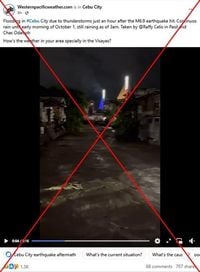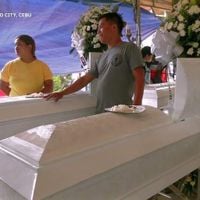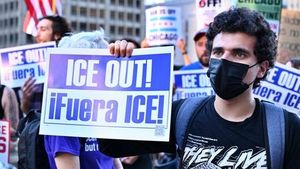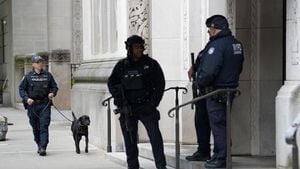On the night of September 30, 2025, the central Philippines was rocked by a powerful 6.9-magnitude earthquake, the most devastating to hit the country in over a decade. According to All Hands & Hearts, the quake struck off the coast of Cebu Island, sending shockwaves that shattered lives and infrastructure across the region. As the dust settled, the true scale of the disaster began to emerge: approximately 18,000 homes lay in ruins, 450,000 people were affected, and the number of fatalities continued to climb.
By October 2, as reported by AFP, the death toll had reached 72, with hundreds more injured and thousands left homeless. The city of Cebu, home to nearly a million residents and a hub of commerce and culture, found itself at the epicenter of a humanitarian crisis. The disaster’s aftermath was marked by dramatic scenes—among the most striking, footage captured the collapse of a church bell tower on Bantayan Island, sending debris crashing to the ground. The quake’s force left power lines, roads, and bridges damaged or destroyed, and authorities quickly declared a state of calamity to mobilize emergency resources.
Driving north from Cebu City, the devastation became undeniable. Families lined the roads under makeshift shelters, holding up cardboard signs that read, “We need food” and “We need water.” Massive boulders and landslides blocked roads, deep cracks split the pavement, and entire communities were cut off from aid. In Bogo City alone, 38 schools sustained damage, further compounding the challenge for families and children already grappling with trauma and displacement.
All Hands & Hearts, a humanitarian organization already present in the Philippines building resilient and sustainable classrooms on Catanduanes Island, was able to respond immediately. Their teams, working alongside long-term local partner Streetlight, sprang into action. Within hours of arriving in Bogo City, they registered with the local command center to coordinate efforts and identify the most vulnerable communities. The first delivery of aid took place on October 4 in Polambato Barangay, a housing community originally built for survivors of Typhoon Yolanda. Many residents, having rebuilt their lives once before, now faced the prospect of displacement yet again as the earthquake rendered their homes unsafe.
Relief efforts focused on the most urgent needs: electricity, shelter, food, and hygiene. Six generators were purchased and flown in to supply power for small shelters and community hubs. The first two generators, along with fuel and extension cords, supported more than 220 households in Polambato Barangay. Plans were swiftly put in place to distribute family and hygiene products to reach 4,000 households in the days ahead. The scale of the operation underscored the resilience and determination of both local residents and aid workers, as they navigated treacherous roads and impassable terrain to reach isolated communities.
Amid the chaos, search and rescue operations continued, even as aftershocks rattled nerves and hampered efforts. According to Vantage Shots, thousands of people were displaced, seeking refuge in temporary shelters or with relatives. Hospitals were overwhelmed, struggling to care for the injured as the number of casualties mounted. The situation was further complicated by repeated aftershocks, which posed ongoing risks to both survivors and those attempting to deliver aid.
As if the earthquake’s devastation weren’t enough, Cebu City was hit by thunderstorms just hours after the quake, compounding the misery for those already reeling from loss. But not all the images circulating online told the true story. According to AFP, a video that went viral—amassing over 400,000 views—purported to show flooding in Cebu City caused by the post-quake thunderstorms. However, a closer look revealed that the video’s first segment was actually filmed during heavy rains in August, weeks before the earthquake struck. Local media such as ABS-CBN and SunStar Cebu confirmed that the August floods had already caused significant disruption, with residents evacuated from villages along the Guadalupe River.
The second clip in the viral video, however, was genuine, showing flooding caused by thunderstorms on the night of September 30. Local resident Raffy Celis filmed the scene as rainwater surged through his neighborhood, a stark reminder of the multiple hazards facing the region. Thunderstorms continued overnight in Cebu City, about 100 kilometers from the earthquake’s epicenter near Bogo City. The confusion caused by the viral video highlighted the challenges of misinformation in the wake of disasters, as people struggled to discern fact from fiction in real time.
In the days following the quake, the focus shifted from immediate rescue to longer-term recovery. Authorities and aid organizations faced the daunting task of restoring basic services, clearing debris, and providing shelter for the thousands left homeless. The declaration of a state of calamity allowed for the rapid mobilization of resources, but the sheer scale of destruction meant that many communities remained cut off and in dire need of assistance. The Philippine government, local officials, and international partners coordinated efforts to deliver food, water, and medical care to those most affected.
Despite the challenges, stories of resilience and solidarity emerged. Communities banded together, sharing what little they had and supporting one another through the ordeal. Aid workers, many of whom had experience responding to previous disasters like Typhoon Yolanda, brought expertise and compassion to their work. The presence of organizations like All Hands & Hearts, already embedded in the region, proved crucial in mounting a swift and effective response.
The earthquake’s impact extended beyond the immediate loss of life and property. The destruction of schools and the displacement of families threatened to disrupt education and livelihoods for months, if not years, to come. Rebuilding would require not only physical reconstruction but also psychological support for those traumatized by the disaster. As the world watched, the people of Cebu and the central Philippines faced the long road to recovery with determination and hope, drawing on the strength of community and the support of a global network of aid and solidarity.
As rescue teams pressed on and relief supplies trickled in, the region’s resilience was on full display. While the scars of the September 30 earthquake will remain for years, the outpouring of support and the steadfast spirit of those affected offered a glimmer of hope amid the devastation.





